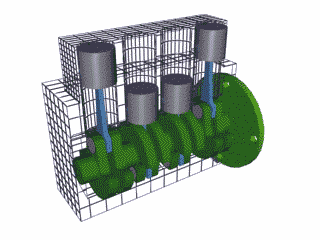Drive train
The drive train of a vehicle refers to the group of components that act to deliver power to the driving wheels of a vehicle. The power to run a vehicle starts in the crankshaft. It is then delivered to the clutch, via the flywheel (in a manual transmission), or to a torque-converter (in an automatic). Power then goes to the transmission, where it is redirected to the drive shaft (also called prop shaft, driveline or propeller shaft). The drive shaft directs the power to the drive axle, which contains both a final drive gear, and a differential. The final drive gear connects the drive shaft to the differential, which then directs power to each wheel. Below is a more in depth explanation of the individual mechanisms discussed in the above paragraph.
Crankshaft

The crankshaft (see figure 1) is a device whose job is to convert the linear motion of the pistons into rotational motion (spin). It is where the power delivery to the drive train comes from. In effect, the crankshaft is the connection between the engine and the drive train. The end of one and the beginning of another.[2]
Flywheel
- A flywheel is only present in manual transmissions.
The flywheel is the part of the engine least often mentioned. It's job is to keep power delivery to the drive train continuous. Since reciprocating engines (piston-driven) only deliver power during a stroke, their power production is not continuous. Imagine riding a bike up a steep hill. Even in a low gear, the ride is choppy - the bike slows down significantly between pedal strokes (losing momentum). This is inefficient since additional work must be done by the rider to regain the lost momentum. A flywheel can help prevent this loss of momentum, it stores rotational kinetic energy which eventually gets transformed into translational kinetic energy (i.e the moving car). Work is done by the engine on the flywheel causing it to spin faster until the drive train utilizes this energy which, by the law of conservation of energy, causes the flywheel to slow down. A flywheel keeps the car moving smoothly and more efficiently.
Clutch/Torque converter

Manual transmission cars have a clutch. Its purpose is to connect the power delivery to the transmission. When the clutch pedal is not pressed, power is delivered, when the clutch pedal is pressed, the car's wheels spin freely.
Automatic cars don't have a clutch pedal. These cars have a torque converter (see figure 2). A torque converter is a device filled with fluid that transmits torque (and power) to wheels of the car. A torque converter allows for an engine to sit at idle while the car is stopped. The torque converter also contains something called a friction clutch, which locks the crankshaft to the gearbox when driving on the highway (fluctuating power levels aren't as big of an issue at steady speeds). So even automatic cars have a form of clutch, but it's not connected directly to a pedal for the driver.
Transmission
A transmission, also known as a gear box, is what converts the engine's power into motion.[4] Just like the gears on a bike. The amount of power an engine outputs at a specific RPM is the same, no matter if a car is going 10 kph, or 110. Because of this, the car has a gearbox, which allows the engine to run at efficient RPMs no matter its speed.
Drive shaft
A drive shaft, also known as a prop shaft, or driveline, is what connects the gearbox to the drive wheels. A rear-wheel drive car has a long, thin cylinder running the length of the car to the rear final drive and differential (often visible when looking under a car). The prop shaft spins at a rate proportional to the speed of the car.[5]
Drive axle
The drive axle is the axle that connects the drive wheels to the prop shaft. It generally has a differential in the middle, which splits power between the wheels.
Final drive
The final drive is like a gear on a bicycle crank (big - found on front of bike). In comparison the gearbox is like the gears on the cassette (little - found on the back of bike). The little gears change all the time, depending on the output, but the big gear up front stays the same. Desired performance determines how the final drive gears are set. When climbing a hill on a bike, the little gear up front is best, because it provides a low gear ratio. When going as fast as possible, a big gear up front is best, providing a high gear ratio. This is what a final drive gear does. The difference is, a car only has one final drive gear - set at production, instead of potentially two or three as on a bike.
Differential
The differential is a device that allows wheels to spin at different speeds while still being powered.[4] For example, when travelling around a corner, the outside wheel is spinning faster than the inside wheel, because it's going a longer distance. Rear-wheel drive cars require something called a limited-slip differential in order to provide even power while turning. Watch the video below to learn how differentials work (video starts at 1:50).
References
- ↑ http://auto.howstuffworks.com/engine2.htm
- ↑ Wise Geek, What is a Crankshaft? (with pictures) [Online], Available: http://www.wisegeek.org/what-is-a-crankshaft.htm
- ↑ http://auto.howstuffworks.com/enlarge-image.htm?terms=torque+converter&page=2
- ↑ 4.0 4.1 Popular Mechanics, How It Works: The Drivetrain [Online], Available: http://www.popularmechanics.com/cars/how-to/a250/1302716/
- ↑ Wise Geek, What is a Drive Shaft? [Online], Available: http://www.wisegeek.com/what-is-a-drive-shaft.htm

